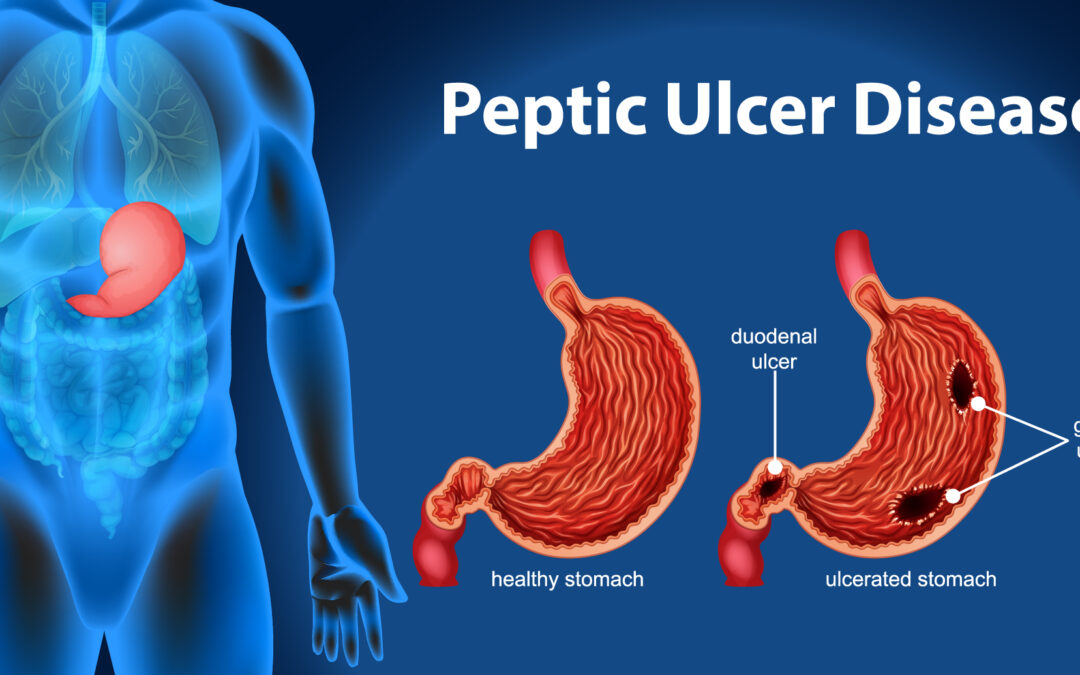Peptic ulcer disease, commonly called Stomach Ulcer can be described as a sore that develops on the lining of the oesophagus, stomach (gastric Ulcer) and the first part of the small intestine (Duodenal Ulcer).
Most PUs are associated with abdominal discomfort 45 to 60 minutes after meals or during the night described as gnawing, burning, cramplike, aching, or heartburn.
Globally, researchers estimate that around 8.09% had at least one peptic ulcer in 2019, which marked a 25% increase from 1990. The same study reported that cases in the United States had decreased since the first half of the 20th century. They started to increase again between 1990 and 2019.
Physiology
The stomach normally contains and produce Acid which is necessary for adequate food digestion. A physiologic balance exists between acid secretion in the stomach and its mucosal defense. This balance is critical in preventing PU.
Protective mechanism of the stomach.
Secretion of mucous in the stomach wall.
Production of gel like covering
Production of Bicarbonate that neutralize the acid produced in the stomach.
Aggressive Or Risk Factors:
1. Drugs – Ibuprofen, Diclofenac, Aspirin are drugs classified under Nonsteroidal anti-inflammatory drugs (NSAIDs). They reduce the stomach’s ability to make a protective layer of mucous. This makes it more susceptible to damage by stomach acid. NSAIDs can also affect the flow of blood to the stomach, reducing the body’s ability to repair cells.
2. H. pylori infection – A bacteria infection that produces an enzyme called urease that increases acid production.
Other causes include;
3. Alcohol
4. Tobacco Use
5. Severe stress
6. Genetics: Many individuals with peptic ulcers have close relatives with the same problem, suggesting that genetic may be a contributing factor.
7. Chronic Disease Conditions.
8. Caffeine or coffee containing product or drugs.
Symptoms
1. Dyspepsia, which is characterized by..
Belching
Bloating
Distention
Fatty food intolerance
2. Chest Discomfort
3. Heart burn
4. Black or bloody stool (in severe cases)
5. Nausea
6. Vomiting
In some cases, ulcers can cause severe signs and symptoms and bleeding. Signs the ulcer is bleeding include:
1. Vomiting of blood.
2. Black and tarry stools, or stools with dark red blood
3. Nausea and vomiting that is especially persistent and severe
These symptoms indicate a medical emergency. The patient should see a doctor immediately .
Diagnosis
The Doctor is able to suspect peptic Ulcer with the symptoms alone, further tests carried out to help with the diagnosis may include
1. A blood test to check for H. pylori.
2. Urea breath test, which uses a radioactive carbon atom to detect H. pylori
3. Fecal or stool antigen test to detect H. pylori in the Feaces.
4. Endoscopy, the use of a tube-like instrument installed with a camera to check through the stomach and Intestine. This is usually used to confirm the diagnosis of Peptic Ulcer.
Treatment
Treatment will focus on either lowering stomach acid levels to allow healing of the Ulcer or eradication of the H. pylori infection. The treatment methods a doctor recommended include
- ITriple therapy. This involves using two antibiotics and a proton pump inhibitor to eradicate H. pylori. This is usually the first line of treatment.
Antisecretory agents. These include H2 receptor antagonists and proton pump inhibitors to help block or lower stomach acid production.
Discontinue Use of NSAIDs. As it is one of the aggravating factor, it should be stopped while using an alternative medication.
Surgery. In cases of bleeding, surgery may be recommended.
Dietary changes or modifications. This is an important aspect of treatment and prevention of Peptic Ulcer. Some foods and flavorings may cause the stomach to produce acids. This can vary for some people, but common causes include chili powder, garlic, Pepper, Coffee and foods high in fat content, for example fried and spicy foods.
Alcohol has the same effect on the stomach so a person should avoid it as well.
A balanced diet filled with fruits and vegetables and lacking in intense spices and flavors may help a person feel better.
However, it is important to note that diet alone cannot treat or prevent peptic ulcers so additional treatment may be necessary
Eat a diet rich in fruits and vegetables (especially those containing vitamins A and C).
Eat foods containing capsaicin (chili), as well as those with flavonoids and sulforaphanes.
Eat probiotics: yogurt, sauerkraut, active yeasts, and aged cheeses.
Avoid nonprobiotic dairy products such as milk.
Eat breakfast every day, and avoid eating large meals shortly before sleeping.
Minimize use of nonsteroidal antiinflammatory drugs.
Avoid smoking cigarettes.
Avoid excessive alcohol consumption.
Maintain a moderate exercise routine.
Obtain adequate sleep.
Develop and incorporate stress reduction activities.
SOURCES
Levenstein, S., et al. (2015). Psychological stress increases risk for peptic ulcer, regardless of Helicobacter pylori infection or use of nonsteroidal anti-inflammatory drugs.
https://pubmed.ncbi.nlm.nih.gov/25111233/
Peptic Ulcer Disease, Medscape 2022. https://emedicine.medscape.com/article/181753-overview
Malik, T. F., et al. (2022). Peptic ulcer disease. https://www.ncbi.nlm.nih.gov/books/NBK534792

